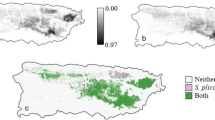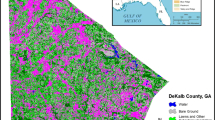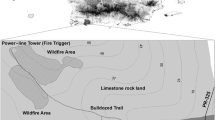Abstract
The role of urban areas in the introduction of alien plant species, and their subsequent spread in the countryside, has long been identified. However, it was mainly considered indirectly due to the lack of data on the frequency of planting of alien species and their early stages of colonization. In this study, we took advantage of the spectacular flowering of the pampa grass (Cortaderia selloana), a tall ornamental plant, visible from afar, to study the spatial dynamics of planted and naturalized stands (i.e. those resulting from seed dispersal) over 600 km2 and over an 11-year period. Using distance sampling methods, we detected 216 and 241 planted stands in 2002 and 2013, respectively. In 2002, we also detected 853 naturalized stands, closely associated with anthropogenic habitats around urban areas. Such spatial association could have represented the initial stages of a spread from urban areas to natural habitats. However, 11 years later, this very close association between naturalized stands and urban areas has not weakened, suggesting a persistent pattern. In both 2002 and 2013, less than 15% of naturalized individuals grew up in natural habitats, almost all limited to the edges of reed beds where they did not threaten local biodiversity. Our study shows that the massive introduction of an alien plant into urban areas, and its subsequent massive naturalization, does not necessarily means its spread to natural habitats. On the contrary, it can remain closely associated with anthropogenic habitats.

(source: land use map of the Camargue Regional Natural Park in 2011, http://www.pnrpaca.org)


Similar content being viewed by others
References
Aikio S, Duncan RP, Hulme PE (2012) The vulnerability of habitats to plant invasion: disentangling the roles of propagule pressure, time and sampling effort. Glob Ecol Biogeogr 21:778–786. doi:https://doi.org/10.1111/j.1466-8238.2011.00711.x
Akasaka M, Osawa T, Ikegami M (2015) The role of roads and urban area in occurrence of an ornamental invasive weed: a case of Rudbeckia laciniata L. Urban Ecosyst 18:1021–1030. doi:https://doi.org/10.1007/s11252-015-0466-4
Blackburn TM, Pyšek P, Bacher S et al (2011) A proposed unified framework for biological invasions. Trends Ecol Evol 26:333–339. doi:https://doi.org/10.1016/j.tree.2011.03.023
Blackburn TM, Prowse TAA, Lockwood JL, Cassey P (2013) Propagule pressure as a driver of establishment success in deliberately introduced exotic species: fact or artefact? Biol Invasions 15:1459–1469. doi:https://doi.org/10.1007/s10530-013-0451-x
Blackburn TM, Essl F, Evans T et al (2014) A Unified Classification of Alien Species Based on the Magnitude of their Environmental Impacts. PLoS Biol 12:e1001850. doi:https://doi.org/10.1371/journal.pbio.1001850
Botham MS, Rothery P, Hulme PE et al (2009) Do urban areas act as foci for the spread of alien plant species? An assessment of temporal trends in the UK. Divers Distrib 15:338–345. doi:https://doi.org/10.1111/j.1472-4642.2008.00539.x
Buckland ST, Anderson DR, Burnham KP et al (2001) Introduction to Distance Sampling: Estimating Abundance of Biological Populations. Oxford University Press, Oxford
Catford JA, Vesk PA, White MD, Wintle BA (2011) Hotspots of plant invasion predicted by propagule pressure and ecosystem characteristics. Divers Distrib 17:1099–1110. doi:https://doi.org/10.1111/j.1472-4642.2011.00794.x
Dehnen-Schmutz K (2011) Determining non-invasiveness in ornamental plants to build green lists. J Appl Ecol 48:1374–1380. doi:https://doi.org/10.1111/j.1365-2664.2011.02061.x
Dehnen-Schmutz K, Touza J (2008) Plant invasions and ornamental horticulture: pathway, propagule pressure and the legal framework. Floric Ornam Plant Biotechnol 5:15–21
Dehnen-Schmutz K, Touza J, Perrings C, Williamson M (2007) The Horticultural Trade and Ornamental Plant Invasions in Britain. Conserv Biol 21:224–231. doi:https://doi.org/10.1111/j.1523-1739.2006.00538.x
Domenech R, Vila M (2006) The role of successional stage, vegetation type and soil disturbance in the invasion of the alien grass Cortaderia selloana. J Veg Sci 17:591–598. doi:https://doi.org/10.1111/j.1654-1103.2006.tb02483.x
Domènech R, Vilà M (2007) Cortaderia selloana invasion across a Mediterranean coastal strip. Acta Oecol 32:255–261. doi:https://doi.org/10.1016/j.actao.2007.05.006
Domènech R, Vilà M (2008) Cortaderia selloana seed germination under different ecological conditions. Acta Oecol 33:93–96. doi:https://doi.org/10.1016/j.actao.2007.09.004
Donaldson JE, Hui C, Richardson DM et al (2014) Invasion trajectory of alien trees: the role of introduction pathway and planting history. Glob Change Biol 20:1527–1537. doi:https://doi.org/10.1111/gcb.12486
Ernoul L, Sandoz A, Fellague A (2012) The evolution of two great Mediterranean Deltas: Remote sensing to visualize the evolution of habitats and land use in the Gediz and Rhone Deltas. Ocean Coast Manag 69:111–117. doi:https://doi.org/10.1016/j.ocecoaman.2012.07.026
Essl F, Dullinger S, Rabitsch W et al (2011) Socioeconomic legacy yields an invasion debt. Proc Natl Acad Sci 108:203–207. doi:https://doi.org/10.1073/pnas.1011728108
Francis RA, Chadwick MA (2015) Urban invasions: non-native and invasive species in cities. Geography 100:144–151
Fried G, Caño L, Brunel S et al (2016) Invasive plant species in Europe: Baccharis halimifolia L. Bot Lett 163:1–27
Gavier-Pizarro GI, Radeloff VC, Stewart SI et al (2010) Housing is positively associated with invasive exotic plant species richness in New England, USA. Ecol Appl 20:1913–1925. doi:https://doi.org/10.1890/09-2168.1
Global Invasive Species Database (2006) Cortaderia selloana (grass). http://www.issg.org/database/species/distribution.asp?si=373&fr=1&sts=sss&lang=EN. Accessed 6 Aug 2015
IUCN (2000) IUCN guidelines for the prevention of Biodiversity loss caused by alien invasives species. Approved by the 51st Meeting of the IUCN Council, Gland Switzerland, February 2000
Jackson CH (2011) Multi-state models for panel data: the msm package for R. J Stat Softw 38:1–29
Kadmon R, Farber O, Danin A (2004) Effect of roadside bias on the accuracy of predictive maps produced by bioclimatic models. Ecol Appl 14(2):401-413
Lambrinos JG (2001) The expansion history of a sexual and asexual species of Cortaderia in California, USA. J Ecol 89:88–98. doi:https://doi.org/10.1046/j.1365-2745.2001.00524.x
Lockwood JL, Cassey P, Blackburn T (2005) The role of propagule pressure in explaining species invasions. Trends Ecol Evol 20:223–228. doi:https://doi.org/10.1016/j.tree.2005.02.004
Mack RN (2005) Predicting the Identity of Plant Invaders: Future Contributions from Horticulture. Hortic Sci 40:1168–1174
Marco A, Leblay E (2010) Fiche espèce Cortaderia selloana (Schultes) Asch. et Graebner
Marques TA, Buckland ST, Borchers DL, Tosh D, McDonald RA (2010) Point transect sampling along linear features. Biometrics 66(4):1247-1255
Minton MS, Mack RN (2010) Naturalization of plant populations: the role of cultivation and population size and density. Oecologia 164:399–409. doi:https://doi.org/10.1007/s00442-010-1667-4
Monserrat AL, Celsi CE, Fontana SL (2012) Coastal Dune Vegetation of the Southern Pampas (Buenos Aires, Argentina) and Its Value for Conservation. J Coast Res 279:23–35. doi:https://doi.org/10.2112/JCOASTRES-D-10-00061.1
Okada M, Ahmad R, Jasieniuk M (2007) Microsatellite variation points to local landscape plantings as sources of invasive pampas grass (Cortaderia selloana) in California. Mol Ecol 16:4956–4971. doi:https://doi.org/10.1111/j.1365-294X.2007.03568.x
Pergl J, Sádlo J, Petřík P et al (2016) Dark side of the fence: ornamental plants as a source of wild-growing flora in the Czech Republic. Preslia 88:163–184
Perrings C, Dehnen-Schmutz K, Touza J, Williamson M (2005) How to manage biological invasions under globalization. Trends Ecol Evol 20:212–215. doi:https://doi.org/10.1016/j.tree.2005.02.011
Pino J, Font X, Carbó J et al (2005) Large-scale correlates of alien plant invasion in Catalonia (NE of Spain). Biol Conserv 122:339–350. doi:https://doi.org/10.1016/j.biocon.2004.08.006
Pyšek P, Jarošík V, Hulme PE et al (2010) Disentangling the role of environmental and human pressures on biological invasions across Europe. Proc Natl Acad Sci 107:12157–12162. doi:https://doi.org/10.1073/pnas.1002314107
Pyšek P, Jarošík V, Pergl J (2011) Alien Plants Introduced by Different Pathways Differ in Invasion Success: Unintentional Introductions as a Threat to Natural Areas. PLoS ONE 6:e24890. doi:https://doi.org/10.1371/journal.pone.0024890
R Core Team (2014) R: A language and environment for statistical computing. R Foundation for Statistical Computing, Vienna
Ricciardi A, Hoopes MF, Marchetti MP, Lockwood JL (2013) Progress toward understanding the ecological impacts of nonnative species. Ecol Monogr 83:263–282. doi:https://doi.org/10.1890/13-0183.1
Saura-Mas S, Lloret F (2005) Wind effects on dispersal patterns of the invasive alien Cortaderia selloana in Mediterranean wetlands. Acta Oecologica-Int J Ecol 27:129–133. doi:https://doi.org/10.1016/j.actao.2004.12.001
Seber GAF (1982) The estimation of animal abundance and related parameters, 2nd edn. Chapman, London and Macmillan, New York
Thomas L, Buckland ST, Rexstad EA et al (2010) Distance software: design and analysis of distance sampling surveys for estimating population size. J Appl Ecol 47:5–14. doi:https://doi.org/10.1111/j.1365-2664.2009.01737.x
Wittmann MJ, Metzler D, Gabriel W, Jeschke JM (2014) Decomposing propagule pressure: the effects of propagule size and propagule frequency on invasion success. Oikos 123:441–450. doi:https://doi.org/10.1111/j.1600-0706.2013.01025.x
Acknowledgements
This study was partly funded by the French Ministry of Ecology and Sustainable Development (MEED, Project INVABIO, 2001–2006).
Author information
Authors and Affiliations
Corresponding author
Rights and permissions
About this article
Cite this article
Charpentier, A., Kreder, M., Besnard, A. et al. How Cortaderia selloana, an ornamental plant considered highly invasive, fails to spread from urban to natural habitats in Southern France. Urban Ecosyst 23, 1181–1190 (2020). https://doi.org/10.1007/s11252-020-01003-4
Published:
Issue Date:
DOI: https://doi.org/10.1007/s11252-020-01003-4




